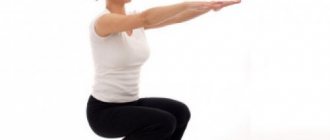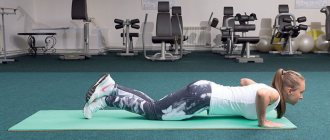Any sport involves serious stress, and our body’s resources are not always sufficient to withstand them. A striking example of this is the respiratory system, or popularly “breathing”. If it is not developed enough, then no amount of physical strength will lead to the desired result. Therefore, one of the main tasks for any athlete is the development of breathing.
As you already understand, good breathing is mainly of interest to those for whom sports and a healthy lifestyle are more than words or hobbies. Let's find out how to develop breathing in order to discover new heights in sports and make the body more resilient, which is much more important than any medals.
How to strengthen the respiratory system
The development of the respiratory organs is promoted by systematic aerobic exercise.
Key sports that develop breathing include: running, swimming, mountaineering, cycling, rowing, speed skating and race walking. Exercise helps increase lung capacity and strengthen the heart. With regular exercise, the condition of the blood vessels improves: they become more elastic. Aerobic exercise strengthens the body as a whole.
Its ability to withstand heavy loads over a long period of time is called endurance. Don’t think that only professional athletes or law enforcement officers need endurance. A person leading an active lifestyle cannot do without it.
Essence and basic principles
Endurance is divided into 2 types: muscular and cardiovascular. The first is how long and at what speed the muscles will recover and contract. Training involves frequent repetition of basic exercises. You can do push-ups, pull-ups, squats and all exercises in several approaches.
The essence of cardiovascular endurance is how long internal organs are able to work during exercise: lungs, blood vessels, heart. This requires cardio exercise: running, jumping rope, cycling.
Endurance exercises are divided into the following types:
- Aerobic exercise. With their help, it is possible to strengthen the heart muscle and blood vessels, remove extra pounds, preserve muscles and significantly improve lung function. This type of exercise includes running and swimming.
- Speed training. Aimed at doing the exercise as quickly as possible.
- Circular loads. Their essence lies in the fact that they can be performed in a small space, repeating the complex several times. Experts advise doing from 4 to 8 repetitions of the complex, reducing the time of doing the exercises with each new circle, increasing the intensity.
- Special exercises. Their essence is to give maximum load to a specific muscle group. This complex is mainly used by athletes who require strength and endurance in a specific part of the body.
Endurance exercises help improve your health. During aerobic exercise, a large amount of oxygen enters the blood, due to which carbohydrates are broken down, transformed into energy, and excess subcutaneous fat is eliminated.
Also during training, the number of small capillaries that nourish the skin and all internal organs increases significantly. In this case, the body receives more oxygen and nutrients.
The heart and lungs begin to function better:
- the heart muscle pumps more blood, which means the organs are better supplied;
- mitochondria - energy factories inside cells, grow, improving the functions of each cell;
- the lungs work better, saturating each organ with more oxygen;
- lactic acid dissolves better in muscle fibers;
- red muscle fibers develop better.
Rules: how to increase your breathing capacity when running
First, remember that breathing technique directly affects the speed of the heart: by breathing chaotically, knocking out the rhythm, you create an artificial arrhythmia, which creates unnecessary stress on the internal organs. If tingling occurs in the area of the heart muscle while jogging, you should reduce the intensity of the workout.
Secondly, follow a few basic guidelines that will help improve your endurance. Read more about them below.
Fresh air
Train in places where there is a lot of oxygen: in a park or forest. You should not run near the highway or in industrial areas, because along with oxygen we also absorb harmful impurities.
Adjusting the depth of breathing
At rest or in sleep, we breathe shallowly, taking a shallow breath and barely noticeable exhalation, and take a deep breath about once every 5 minutes. But this method is ineffective while running.
You can develop your breathing by breathing alternately with medium and full force. Filling your lungs with air as much as possible only makes sense when you feel a lack of oxygen. At any other time, moderate intensity is optimal.
Do not inhale deeply at every step - this will quickly cause you to feel an O2 deficiency, which will be accompanied by dizziness.
Inhalations and exhalations have their own turn
Each cycle should be one or two steps, depending on the rhythm and speed of movement.
Rhythm and frequency
When the pace goes wrong, the same thing happens with the breathing process: oxygen enters the body unevenly, you choke and cannot continue a systematic run.
Inhale and exhale in different ways
Inhale through your sinuses and exhale through your mouth. This will allow you to most effectively receive O2 from the external environment, warm it, and get rid of processed carbon dioxide.
Holding your breath
The pace will constantly slow down if, while running, you start to get distracted, drink on the go, or talk. By delaying the rhythmic work of your lungs, you deprive yourself of the required volume of air.
Breathe deeper
Experts recommend involving the diaphragm and abdominal muscles in the process. It is important to control and regulate the intensity so as not to lead to oxygen oversaturation.
The body will be able to find a suitable rhythm
There is an opinion that your body knows much better at what pace it is more effective to work. Thus, no special techniques need to be used. The main thing is to catch the natural rhythm that will form at the beginning of the workout and not get out of it. It all depends on the degree of load, speed of movement and objectives of the exercise. Proper breathing during an easy, calm recovery run or warm-up should not leave you out of breath.
Try to choose the option that will be beneficial specifically for your body. Change this or that technique, adjust it to your rhythm, be sure to take into account your well-being and level of physical fitness.
Your main task is to listen to your body and feel its needs. As soon as severe discomfort occurs, try a different breathing pattern.
For long distances, inhale and exhale in 2 steps
This is a classic pattern for athletes who run a marathon. This technique allows you to develop endurance and increase the performance of the body.
Synchronize the process with movement
As discussed below, when running long distances, a 2-2 scenario works well. Having mastered it, you can try increasing the tempo to “3-2”, which will improve your well-being and get more oxygen, or “2-1” to speed up.
Focus on exhaling
In this case, it is better to do it through the mouth. By focusing on clearing carbon dioxide from your lungs, you will prevent the possibility of becoming suffocated.
Shorten your inhalation
By adjusting the depth of breathing, you will normalize the functioning of the heart muscle and understand how to develop and train your breathing system for running.
Breathe through your mouth
You cannot inhale and exhale only through your nose - you risk not getting the proper amount of oxygen from the air. To understand how correctly you alternate between the nasal and oral methods, you need an effort that will allow you to hear yourself during the training process.
Use your stomach
The diaphragm allows for deeper inhalation because it is not limited to the chest and ribs. This method provides the lungs with much more space to expand and fill with oxygen.
Motivation
By and large, many people have known since childhood how to develop breathing and endurance. The simplest exercise for this is running. However, not everyone takes care of their health. Scientists have repeatedly proven that ancient people were incredibly strong, fast and resilient. They had to do a lot of cross-country running.
Anyone who cannot convince himself that he needs to work for the sake of health will receive nothing but suffering from a sports lifestyle. After all, for quality training you need to give up your usual cozy and comfortable lifestyle. So you need to look at training as a way to add youth, positivity, beauty and a few valuable years to your life. It’s not enough to know how to develop breathing, it’s important to understand why it’s being done and to be able to force yourself.
Why does shortness of breath occur when running very long and short distances?
When watching sports broadcasts, you can’t help but be amazed at the dexterity, endurance, speed and coordination of movements. All this is developed through years of hard training. How to develop breathing and endurance for boxing, running and cross-fit? First you need to understand why shortness of breath and weakness occur during physical activity.
There are two types of shortness of breath:
- physiological (occurs in poorly trained people when running, climbing stairs and other loads);
- pathological (occurs at rest).
The cause of any form of shortness of breath can be various cardiovascular and pulmonary problems: heart failure, pre- and post-infarction conditions, bronchial asthma, tuberculosis, pneumonia. If pathological shortness of breath occurs frequently, you should consult a doctor. If you notice only physiological shortness of breath, then you need to train and increase the ability of your lungs to load.
Contraindications for use
Endurance exercises can be performed by everyone, with the exception of those who have a contraindication. You need to start training with minimal load, constantly increasing, complicating and increasing the intensity.
By developing speed and strength endurance, you can do serious anaerobic work. As a result, you manage to gain muscle mass and strength. The relief improves, because working with a large number of repetitions allows you to create the strongest effect, but without it it will not be possible to achieve good fullness and vascularity.
The plank is a classic exercise for developing endurance and strength.
Guided by the principles of endurance training, you don’t have to set any special goals in sports. No one forbids doing everything possible to become stronger and faster, in order to ultimately get rid of extra pounds.
Like any other type of physical activity, endurance training has a number of contraindications.
You should not train endurance for people who have:
- heart and vascular diseases;
- problems in the respiratory system;
- viral and colds and the period of up to 3 weeks after their transfer;
- obesity;
- ailments affecting the joints and spinal column;
- fractures and serious injuries of the limbs;
- weak and deteriorating vision.
Before you start training endurance, you should definitely consult with a specialist, especially if you have a history of chronic illnesses.
What to do to increase endurance
For a long time, everyone has known the most effective exercises for breathing endurance:
- Mask. Or some kind of respiratory mask will do, these are sold in sporting goods. The technique strengthens the muscles of the ribs, which are involved in their expansion and ensuring depth of breathing. Stronger rib muscles allow you to inhale/exhale deeper and easier. If you have diseases of the cardiovascular system or lungs, it is better to avoid this technique.
- Elements of lung exercises from yoga. For example, take sharp inhalations/exhalations for two minutes. Or take deep breaths/exhales, trying to take in as much air as possible and also exhale as much as possible. Hold your breath while inhaling; the duration of the hold must be increased over time.
- Endurance running is good because it trains not only the respiratory system, but also the heart muscle and leg muscles. Some trainers do not recommend running in a monotonous mode. It is better to alternate calm running with acceleration, running over rough terrain and running uphill. A forest belt is ideal for cross-country running. And for safe running at speed and at elevated levels (stairs), a stadium is suitable. Also, if you already show excellent results in running, and moderate exercise takes a lot of time, use weights on your arms and legs. You can also use a backpack and put something heavy inside (water bottles, for example).
- Swimming. Another effective way to improve your breathing for running and, in principle, for any other active activity. In the case of swimming, the shoulder muscles are pumped. This is especially true for boxers, wrestlers and those athletes who need to strengthen their shoulder muscles due to injury. As a rule, the following swimming style is used: Front crawl; Breaststroke; Backstroke; Butterfly.
In general, an athlete’s endurance is divided into special and general. The main definition of endurance in principle is the ability to combat physical fatigue during active muscular activity of a specific nature and specific intensity. In martial arts or team sports, an indicator of the level of endurance is the time during which a certain level of effectiveness of vigorous activity is achieved.
We are specifically interested in general endurance, as the ability to perform long-term work of moderate intensity, but with high efficiency, as well as special endurance, the loads of which relate to a specific sport. Special, in turn, is divided into speed (readiness to make quick movements for a long time without violating the execution technique) and speed-strength, which is accompanied by a high degree of strength activity.
Thus, depending on the type of sport, exercises to increase endurance are supplemented with all sorts of special elements.
What kind of endurance is there?
The concept of endurance covers a fairly wide range of physical characteristics of the body. Respiratory endurance is mainly divided into two types: anaerobic and aerobic.
Anaerobic endurance expresses the body's ability to perform any physical work without the required amount of oxygen. That is, to perform some action, the body spends only internal resources. This type of endurance is developed by performing a large number of exercises in a limited period of time.
Aerobic endurance is the body’s ability to perform work using oxygen. This typically requires a variety of exercises with long sets.
There are also special and general endurance. The first is a distinctive feature of athletes who perform the same action for a long time, achieving perfection in it. Well, the second one is needed by ordinary people who are not chasing medals, but the health and tone of all the muscles and organs of the body. Everyone chooses for themselves what type of endurance to develop - it all depends on the goal.
Who needs it and why?
A hike in the forest, a bike ride, working in the garden - all this and much more requires resources from the body. And even a long shopping trip can turn into a nightmare if you don't have enough stamina.
Trained and resilient people look much better than those who are lazy or constantly need special motivation. They are always fit, dignified, and, of course, there are no extra pounds. Such people move accurately, quickly, and confidently. However, external changes are only the first side of the coin. There are also internal changes. With constant and competent training, the composition of the blood changes (the number of red cells increases), which helps enrich the internal organs with oxygen. The respiratory muscles of trained people are stronger, as is the heart muscle.
How to train your breathing for swimming
If you experience breathing problems while running, it means:
- Respiratory muscles are poorly developed;
- The brain does not receive the required amount of oxygen;
- You are breathing incorrectly;
- There may be a lack of red blood cells in the blood.
Theoretically, muscles and red blood cells will appear from regular exercise, the body itself will compensate for the missing elements.
But you need to practice breathing:
- While running, watch how you breathe;
- Try to do no more than 16-18 breathing movements per minute;
- The “inhale-exhale” complex should take 3-4 seconds;
- Breathe rhythmically, try not to lose your breath as long as possible.
We suggest you familiarize yourself with Full Body Weight Training
You shouldn’t try to run a marathon right away. Start small - 1-2 laps around the stadium, at a slow pace. Gradually increase both the speed and the number of laps.
You can use weights, but only carefully and correctly dose the load. Any exercise with this equipment improves performance, but forces you to work somewhere at the limit of your capabilities or even beyond it.
There is no “magic pill” that will teach you to run for a long time and not lose your breath. There is only the running itself - long and tedious, every day, regardless of the weather and mood.
This is a fairly common question, since many people run, and the lion's share of them are not professional athletes. Such people usually have no problems with excess weight, their body is always in good shape, and their mood is high. While jogging, the respiratory organs begin to work much faster, and the blood is enriched with oxygen, supplying the internal organs and the brain.
If you are starting to join the running culture, then you should pay attention to three main principles: gradualism, consistency, and acceptability. Let's look at each of them.
- Gradualism. From the first day you should not take on hours of training. You need to increase the distance carefully, controlling the pace and your condition. Those who decide to use running to restore their respiratory system after smoking should be especially careful with the intensity of their training. It must be remembered that the body must rest well and recover from the stress it has endured.
- Systematicity. To achieve even the smallest results, you need to perform exercises regularly. This is the only way to improve your endurance and physical condition.
- Eligibility. The load should be enjoyable and nothing else. If every workout is torture, but you run twice as much, soon the desire to run will disappear. Let it be better the other way around – a short run, done correctly and with pleasure.
Swimming, like running, is a sport in which breathing plays a crucial role, especially if it is swimming underwater. If a swimmer does not know how to breathe correctly, he will not be able to conquer long distances. Let's look at a couple of exercises to train breathing while swimming.
- While standing in the water, you need to inhale and immerse your face in the water, while holding your breath. Then you need to make two slow swings of your arms. Starting the second swing, you need to start exhaling air into the water; by the end of the swing, you should complete the exhalation and raise your head above the water. Then inhale and the exercise is repeated.
- The exercise is also performed at shallow depths. After taking a deep breath, you need to plunge into the water. Slowly exhale all the air so that the lungs become completely empty. After staying for a couple of seconds without air, you can come up and breathe again. Then everything is repeated. It is advisable to do this exercise energetically and rhythmically, spending a minimum amount of time above the water.
These exercises are very simple, but they answer the question of how to develop breathing for swimming underwater and just swimming.
Endurance development
To cope with a huge load, you should perform endurance breathing exercises:
- Intense rapid inhalations and exhalations. Duration – minute.
- Alternating sharp exhalations and smooth inhalations, then calm exhalations and rapid inhalations.
- Deep breath. After 10 seconds, inhale again. Then again, until the lungs feel full.
- Sharp inhalations through the nose, followed by similar exhalations through the mouth.
Breathe correctly when doing exercises. Push-ups or squats:
- Inhale as you go down, exhale as you go up.
- Take a deep breath, stop breathing. And during this interval, do push-ups or squats as many times as possible.
- Inhale and exhale until the end. Repeat the process steps 1 and 2.
Useful tips
Exercises that help develop endurance have their own differences and characteristics:
- Endurance loves high-quality recuperation, good nutrition and a moderately active lifestyle.
- Complete rest. Endurance is not training for weight loss, where you need to move as much as possible. Between endurance training, you need to give your body proper rest, visit saunas, and get a massage. But a long rest can also provoke a disruption in the recovery process.
- Proper nutrition for full recovery. The diet should be dominated by pure carbohydrates. If you can’t eat more than normal, you need up to 6 g per 1 kg of body weight, then you can use recovery drinks and special gels.
- Alternate between working on strength and endurance. Intensive training includes powerful running, cycling and swimming sessions. Classic training - 30 sec. loads, 1 minute moderate pace.
- Rest between sets should be minimal, and with circuit training there should be no rest.
- The number of repetitions should be at least 12 for a heavy basic program, and at least 15 for a light program.
- It is important to monitor your heart rate during training. You should definitely purchase a heart rate monitor and its needle should not go into the red zone.
- To get maximum benefits, workouts should be done at least 4 times a week.
- Weight is not required, the main thing is the total load and the number of repetitions.
- You can listen to music while exercising. With its help, you can easily keep the pace and improve your mood.
- Include beet juice in your diet. Scientists have proven that it contains large amounts of vitamin C and antioxidants. It helps you get extra carbohydrates and effectively fights fatigue.
The technique of performing exercises that involve endurance training differs from the classical one. You won't be able to build muscle, strength, and endurance at the same time. You should train constantly, even a short break will not be beneficial, all results will be reduced to zero.
Footballers, boxers and children
How to increase endurance in football. It should be understood that in a particular sport there is a specific load. In boxing it focuses on the shoulders and legs, in football it focuses exclusively on the legs. Due to the heavy load, the leg muscles become clogged, which reduces speed and overall productivity (impact strength, ability to maintain a long and intense rhythm). Therefore, after training, it is especially useful to go to a massage or a sauna in order to “break” the muscles and restore their elasticity and lightness. Most training for soccer consists of running and cycling and is practically no different from the tasks of triathlon.
Exercises for breathing and endurance in boxing. In addition to running, swimming, etc., there are also special exercises. For example, working on a bag at an intense pace, for as long as possible. It is important that the strikes are performed correctly, so you need to place a coach or at least a mirror in front of you. This exercise is good because the athlete trains endurance in the most suitable fight situation for him. He must watch his breathing, his arms and shoulders must be relaxed, otherwise they will get tired faster, and the blows must be executed correctly because If the blow is placed incorrectly, no damage will be caused to the opponent.
Shadow boxing is also suitable. You need to stand in front of a mirror, pick up 2-3 kg dumbbells and practice air strikes. After just a couple of minutes, the athlete will feel heaviness in his shoulders. For greater effect, you can wear a special mask, but it is more difficult to breathe in it (contraindicated for athletes with heart problems).
Jumping rope - development of breathing and the ability to move on your feet in boxing. It is also cardio training and the ability to move on relaxed legs. There are no restrictions on working with a skipping rope, start from your own well-being.
Impacts on the pneumatic bag. In this exercise, the emphasis is shifted specifically to the work of the hands. Increases the time you work with your hands and the accuracy of your strikes.
CrossFit is also suitable as an endurance exercise for strikers:
All of the above is circuit training for a boxer. The time for each exercise is 20-30 seconds, the break is 10 seconds. You can also completely eliminate respites.
Nature is the best gym. A pond is suitable as an exercise for a fighter’s endurance - you can practice strikes in it. Use the sticky sandy beach for sparring, running or wrestling. It is much more difficult to move on such a surface than in the ring in boxing shorts.
Here you can also perform exercises for respiratory endurance for a nine-year-old child when swimming. You can swim as your child knows how: doggy style, on his back, etc. If there are difficulties, support the child under the stomach or give him an air mattress. Swimming is a great way to teach breathing. It is in practice that the child will understand the consequences of improper breathing and how dangerous it can be if the depth of the reservoir is large.
Physical endurance exercises at home
The choice among exercises for developing endurance is large, but each of the proposed exercises is basic, which can be performed at any time and anywhere if you have free time.
Let's look at the best of them.
Running allows you to keep your entire body in good shape and also improves your overall health.
- It is very important to maintain an acceptable speed for you while running - this will allow you not to exhaust your body with physical activity, and constantly maintaining it at the same level will make it possible to run more and get the maximum effect.
- It is important to be systematic when running. If you run in the morning, don’t miss a single day. Otherwise, the body will begin to “forget” the amount of load that you gave it previously, and after trying to get back into the process, it may show a lower result.
- In addition to daily jogging, the process of increasing the load is no less important: each time try to run more than before, increase the pace and after increasing it, try not to reduce it.
- “Ragged” running is also popular in the process of developing endurance, but this method should be used no more than 3 times a week, and change the speed about 8 times in one session. It is necessary to run at maximum speed for 30 seconds, and then switch to slow walking for no more than 5 seconds.
When creating an endurance training program, it is necessary to think through it so that there are exercises that enable the athlete to develop in the following parameters:
- flexibility (for the most painless movement of joints);
- muscular endurance (to increase the time it takes to complete an approach while minimizing body fatigue);
- muscle strength (for the physical development of bones and muscles);
- Cardio fitness (to reduce the risk of cardiovascular diseases);
- quality of physique (to improve metabolic processes in the body).
The program is designed for 7 days, with the condition that classes will be held every other day. There will be a total of 4 classes per week.
| Day 1 |
|
| Day 2 | Rest |
| Day 3 |
|
| Day 4 | Rest |
| Day 5 |
|
| Day 6 | Rest |
| Day 7 |
|
We invite you to familiarize yourself with Fitness training at home: effective and simple exercises for losing weight
To achieve the maximum level of development of your own endurance, you need regular training to help your body strengthen in all respects at the same time. As a result, all this will lead to an improvement in the general condition of the body and increased performance in strength training.
Many people are interested in how to train breathing for running at home. Of course, to be good at running, you need to run. But you can make your body more resilient and your body fit at home. To do this, you don’t need to buy expensive exercise equipment. Any physical exercise (push-ups, pull-ups, jumping jacks, etc.)
) have a positive effect on respiratory endurance. An excellent exercise is jumping rope. Jumping rope will not only help tighten the whole body, but will also give a good workout to the respiratory system. A very simple way to develop breathing at home is to inflate balloons. This simple procedure perfectly trains the lungs and heart.
How to quickly increase lung capacity
- Breathing with resistance
To increase your lung capacity even faster, you can try to physically train your breathing, that is, breathe with resistance.
To do this, first breathe normally through your nose. Take a few deep breaths.
Exhale through your mouth, keeping your lips slightly parted. Open them just a little so that some air can escape with resistance.
Try to do this as often as possible to get your lungs used to holding air. This way they will increase. Another way to achieve the same effect is to inflate balloons.
Breathing exercises to increase lung capacity in water
To more effectively perform exercises on breathing and its strength in water, it is recommended to do it in an open body of water (river, lake, sea). If for some reason you do not have this opportunity, then this exercise can be done in the pool.
Submerge yourself in water up to your neck and stay afloat. Just swing your arms and legs in the water, if you can’t, no problem, just go into the water up to your neck so that you can feel the bottom with your feet.
Due to the water compressing your chest, you will reduce your air intake by 25 percent, as a result of which, over time, your body will want to compensate for the shortfall, and you will breathe more efficiently.
- Inhale more than you can
Inhale as much as you can, once you have done this, continue to inhale the air in small sips. Feel your belly expanding. Hold this position for a few seconds and then exhale forcefully. Exhale as long as possible.
Naturally, in various sports there are other more complex special exercises to increase lung capacity and develop the ability to remain without breathing for quite a long time.
At a minimum, swimmers, weightlifters, mountain climbers and yogis have their own exercises, and perhaps we will discuss them another time. And today we tried to choose for you exactly those that are suitable for everyone without special training or exercise equipment.
Naturally, as already said,
Therefore, in conclusion, I would like to advise - play sports, live healthy and BREATHE DEEPER! Well, you can also watch this article in the Video version.
If everything is really bad with your breathing, then before training you should perform the following complex every day for a month:
- diaphragmatic breathing with the stomach for four to six minutes (when inhaling, stick out the stomach as much as possible and draw as much air into the lungs as possible; when exhaling, draw the stomach in);
- chest breathing for five to ten minutes (the stomach is motionless, the inhalation is as deep as possible and the chest protrudes in parallel, and when exhaling it retracts);
- breathing at a fast pace, inhale on a count of two, exhale on a count of one (perform until dizzy);
- relaxed, as slow and deep breathing as possible.
If you have problems with the lungs and alveoli, it is better to do this breathing complex for a month before training. How to develop breathing capacity and endurance for asthmatics? In the presence of such a serious illness, even breathing exercises should be performed only with the approval of the attending physician. But don’t despair, because even if you have asthma, you can become an athlete - the main thing here is not to rush and increase the load very gradually.
Main complex
All exercises aimed at training endurance must be performed for 40 seconds, then take a 20-second break and repeat. This is the only way to get maximum load on all muscle groups, the results will be stunning.
During training, you can use a basic complex or select a special one, taking into account the characteristics of the human body. Here is one of the best complexes that will help you achieve real results in a short time.
Squats
During this exercise, the load is placed on the muscles in the buttocks, calves, abs and tendons located under the knee.
Technique:
- Stand up straight, place your feet shoulder-width apart, toes slightly pointed to the sides.
- Arms bent in front of you. Squat down as low as possible, stand up and bend your right leg at the knee, pressing it to your body. Pull the knee of the right leg as high as possible towards the left elbow.
- You need to squat again and raise your left leg.
This exercise will help train your abdominal muscles.
Technique:
- You should get on your knees. Take a weight in your hands and press it to your chest.
- Tighten your abdominal muscles as much as possible and lean back.
- And now, while bending, you need to turn your body, now in one direction, now in the other, but the abdominal muscles must be constantly tense.
Swings
During this exercise, the muscles of the buttocks, shoulders, back, and thighs are used.
Technique:
- Place your feet slightly narrower than your shoulders, bend them at the knees. One hand is put forward, and the other with a weight is pulled back.
- Stretch your hand with the weight forward, while you need to stand up and level up. Transfer the weight to the other hand.
- During a squat, move your hand with the weight back. And get up again.
During this exercise, the muscles of the chest, abs and lower back are involved.
Technique:
- Take a lying position, palms located under the shoulders and pressed firmly to the floor, legs and eyes looking at the floor, abdominal muscles tense. The chin should not be pressed to the chest.
- Lower the front of the thigh, and then the chest.
- Then, in reverse order, lift the chest, and then the thigh. The result should be a wave.
Burpee with squat
During this exercise, the muscles of the calves, chest, abs, thighs and buttocks are involved.
Technique:
- Lying down, palms pressed to the floor, located under the shoulders, legs straight, gaze directed downward, abdominal muscles tense.
- From a lying position, take a squat position, without lifting your hands from the floor.
- Raise your hands and lock them together in front of you.
- Jump out of a squat.
- Sit down. Take a lying position.
Rock climber
During this exercise, the load is placed on the muscles of the abs, abdomen, chest and thighs.
Technique:
- Take a lying position, arms at shoulder level, straightened.
- The abdominal muscles are tense. Lift your right leg off the floor and pull it forward, your body should be straight.
- Place your foot on the floor and do the same with your left leg.
The exercise should be performed at an intense pace.
Back lunges
The muscles of the buttocks, thighs, and shoulders are involved.
Technique:
- In a standing position, feet shoulder-width apart. Hold the weight with both hands on your right shoulder.
- Lunge your left leg back, squat so that the thigh of your right leg is parallel to the floor and your knee is located directly under your ankle.
- Return to the starting position, raising your arms with the weight above your head.
- Now perform a lunge on the other leg.
The muscles of the chest, shoulders and elbows are trained.
Technique:
- Kneel with your hands on the floor in front of your shoulders. The stomach is pulled in, the legs are crossed.
- Bend your arms at the elbows, lower your body to the floor. Continue to tense your body and straighten your arms. Return to the starting position, raise your left arm.
- Place your hand on the floor and do the exercise using your other hand.
Fold
The rectus and oblique abdominal muscles are trained.
Technique:
- Lie on the floor, arms along your body, legs slightly bent, feet apart.
- Connect the two legs, with the toes of the left touching the foot of the right.
- Return to starting position.
- Connect your left hand with your right leg, lifting your back off the floor, you need to round it, while the abdominal muscles are as tense as possible, your arms are straight.
Plank
During this exercise, almost all muscles are tensed.
Technique:
- Get into the classic plank position with your arms outstretched, your back is straight, your pelvis should not fall too low.
- Lower yourself onto your right elbow, bending it, then bend your left elbow.
- Straighten your right arm, and then your left.
- Perform the exercise at a fast pace.
You can develop endurance both at home, by performing the set of exercises described above, and by visiting the gym.
In the hall you can use the following program:
- It's better to start with running. 15 minutes is enough. per day, while running should be at different paces, for example, 1 minute. in fast, and then in slow. You can run on a treadmill.
- Jumping rope. Push off while jumping with your full foot. Perform the exercise for at least a quarter of an hour. You can alternate jumping techniques.
- Squats. They help develop overall endurance. You can squat using the classic technique or on 1 leg. You can alternate techniques.
- Horizontal bar. You can just hang, and then do 5 sets of pull-ups.
- Leg throw. Standing on all fours, lift your legs one by one, throwing them back as high as possible.
- Press. Twisting will help make the abdominal muscles more prominent, improve breathing, and strengthen the musculoskeletal system.
When creating a training program, you should think about it so that it includes exercises that help develop:
- flexibility - will help joints move without pain;
- muscle endurance;
- muscle strength;
- cardio training;
- quality of physique.
We suggest you familiarize yourself with BCAA during training for weight loss and muscle building
An approximate class schedule for 7 days is described in the table below.
| First day | Running 2 km, plank - 4 sets of 30 seconds, pull-ups on the horizontal bar - 3 sets of 10 times. |
| Second day | Break. |
| The third day | Jumping rope - 4 sets of 1 minute, burpees - 4 sets of 20 seconds. |
| Fourth day | Break. |
| Fifth day | Running 3 km, push-ups - 3 sets of 10 times, jumping in place, with your knees as high as possible - 4 sets of 30 seconds. |
| Sixth day | Break. |
| Seventh day | Squats on 1 leg - 3 sets of 20 times, plank - 4 sets of 1 minute, burpees - 4 sets of half a minute. |
You can include agility exercises in your training, which are distinguished by alternating different techniques. It would be ideal to combine aerobic exercise and strength training. To make the training more effective, you will definitely need additional equipment: a barbell, dumbbells, parallel bars, a horizontal bar, a bench, a ball, a jump rope.
You can achieve real results only if you train regularly.
Homely atmosphere
If you are interested in developing your respiratory system at home, you will need the following activities:
- Warm up.
- Run.
- Jumping rope.
- Vocals
- Inflating rubber balls.
- Hitting the bag.
- Shadow fights.
The program begins with a warm-up. Rotational actions are performed to warm up all joints and tendons, and stretching actions are performed.
Each breathing exercise at home helps develop the chest and lungs. Running brings the greatest effect. You can do it at home if you have a special simulator. But it is better to run in nature and in the morning. You can choose a suitable area or route near your home for these tasks. It’s great if there is a forest, a park or just a school with a stadium nearby.
Exercises for breathing when running at home on a simulator or similar exercise in nature are as follows:
- Changing speakers. At first, the pace is slow. After 400-500 m, accelerate (press the corresponding button on the vehicle). Work at this pace for a minute and slow it down again. After 300-400 m, speed up again and calm down. And such cycles are carried out from 5 to 10 during a running workout.
- Monitor your breathing: inhale through your nose, exhale through your mouth. Inhale – a maximum of 3 seconds, exhale – a second.
- Exercise to develop the respiratory tract. Done after a run. As you walk, take light inhalations and slow exhalations. Use your lips to imitate the pronunciation of the sounds “F” and “W”. The duration of the exhalation is such that you mentally count down to 14.
Consolidate the result
In order for the results to last for a long time, you should not suddenly stop training. Be sure to follow proper nutrition and go to the gym at least 2-3 times a week. If you can’t go to the gym, then you can go for a run at home in the morning, and after it do special exercises.
It is enough to train from 40 minutes to an hour every other day, without taking breaks, and the results will last a long time. Breaks are taken only if shortness of breath occurs and for no more than 3 minutes.
Classes in the hall
They include different sets of exercises, which are usually selected by a trainer. As a rule, the program includes the following breathing exercises in the gym:
- Squats.
- Tilts.
- Jerks and jerks.
- Push ups.
- Pull-ups.
The first three points are performed with equipment: dumbbells, kettlebells or a barbell. Their weight is selected based on your capabilities. For example, working with a barbell (bench press and squats) requires a product that makes up 70% of your weight. For beginners, the criterion is 30-40%.
For beginners, it is advisable to select weights with a parameter of no more than 12 kg. As the form develops, the weight of the projectile increases - up to 16 or 32 kg.
The minimum weight of dumbbells is 6 kg. For shadowboxing – 1-1.5 kg.
An excellent effect on the development of the respiratory tract is the following exercise:
The stand is straight. The air is inhaled with the entire chest and held for half a minute (if it is too heavy - for 10-20 seconds). Synchronously, both arms, holding dumbbells up to 6 kg, are extended forward and held at the shoulder line. After the specified interval, a sharp exhalation follows.
Then the situation is repeated, only the arms are pulled back.
If your physical potential allows, the weight of the apparatus can be increased to 8-10 kg or you can work with weights.
When to expect an effect
Professional trainers who have repeatedly observed the results of their players note that visible results can be seen no earlier than after 12 weeks of hard training. And this is only provided that the person strictly follows the exercise plan, monitors his diet and does not miss workouts.
You just have to miss 2-3 classes and the results will disappear. Then you will have to start all over again, with persistent training, step by step, to move towards your intended goal. Exercises to increase endurance require maximum attention and concentration, just like any other type of training.
Will sport replace war?
In many ways, sport was supposed to replace military action, but it didn’t work out:
- Sports competitions have been known since ancient times;
- At best, wars were suspended for the duration of the war, but there was no talk of achieving long-term peace;
- Countries have exhibited and continue to exhibit their athletes as gladiators in confrontation with each other;
- Another sports victory is a reason for joy and pride for a couple of days or even longer for the whole country;
- It was not possible to sublimate all the aggression and direct it into a peaceful direction;
- Sports began to look more like politics than war itself.
It would probably be easier to live if conflict situations were resolved not through combat, with the participation and death of millions of soldiers, but through sports or intellectual competitions. Whose “gladiator” won is right.
Although even this looks like a dubious solution to really important problems. The prospect of getting rid of senseless bloodshed, but it is too early to talk about justice.
And no one will accept such a scenario where, in case of loss, you can still “put a couple of million soldiers under arms” and go on the offensive.
Why is running so difficult?
Running is simple, fashionable and healthy:
- You can train at any time of the year;
- There is no need to buy any additional equipment for classes;
- You can run near your home or in the nearest park; there is no need to go to a gym located on the other side of the city;
- Jogging will only improve your health; there are simply no negative effects.
And the inspired future athlete goes out to the stadium, makes a circle, tries to go second and realizes that something is wrong with him.
Not at all like that:
- Breathing became unsteady;
- Begins to stab in the side;
- The heart is ready to jump out of the esophagus;
- The leg muscles are tired;
- It's getting dark before my eyes/
All these “bells” indicate that someone is either not naturally resilient, or has been sitting in an office chair for too long and has completely neglected himself. In any case, you need to do something and improve your performance. Gradually, overcoming yourself and trying.
And one more thing - once you decide to “pump up” your endurance, you will have to do this for a very long time. After all, the results regress quickly as soon as the additional loads go away.
It is not possible to become resilient once in your life and remain so for the rest of your days, without training and exercise.
How to develop strength endurance?
A useful thing - having reached the peak load, you can work for another 3-4 minutes, at maximum voltage. But only if you train yourself:
- Anaerobic endurance is important when work is performed without oxygen;
- This type can only be trained with intense loads with a very short recovery period;
- It is necessary to perform any exercise practically at your maximum performance, making a minimum gap between approaches;
- Dumbbells, barbells, and any exercise equipment will do;
- It is better to exercise under someone’s supervision; you should not train on your own.
Every time you exhaust yourself from fatigue, but force yourself to do the exercise again, you develop strength endurance, which will be useful in extreme situations or to achieve truly outstanding results.
Naturally, for such training you need to be in excellent health and already understand something about this matter. For beginners, such activities can be too dangerous.
How we breathe
The human respiratory system is directly connected to the circulatory system. Thanks to this connection, oxygen is extracted from the inhaled air mass, enters hemoglobin and is transported throughout the body. To increase the efficiency of consuming this substance, maintain rhythm: control the depth and frequency of inhalation.
It is also worth thinking about the quality of the environment. The best place for running is a park: the more greenery around, the cleaner the air. Plants absorb carbon dioxide and release the pure oxygen we need so much.
Nose or mouth
When jogging, nasal breathing is preferable. Inhale on each step (or on the second if you are using your lungs at full strength), and exhale as you lift your leg (or lift it again if the rhythm is slow).
Do not be afraid of the formation of stabbing pain in your side. Its occurrence means the accumulation of blood in the spleen or liver, which is under pressure from the diaphragm, but this is not dangerous. As soon as unpleasant sensations appear, adjust the intensity of your running: let each inhalation and exhalation fall on the opposite side (if it tingles on the right, breathe when your left foot touches the ground, and vice versa).
Breathing through the mouth is not recommended, since oxygen in this case will dry out the mucous membrane of the oral cavity, causing additional loss of moisture and, as a result, discomfort. In this case, the air does not enter directly into the lungs, but partially into the stomach.
The best option is to inhale through your nose and exhale through your mouth.
There are various breathing techniques, each of which corresponds to its own goals and training format. By correctly using and combining techniques, you can significantly increase the effectiveness of your classes. So, during the warm-up process, it is better to breathe through your nose, without adjusting to the rhythm of your steps - this will activate the activity of the chest and reduce pressure on the liver or spleen.
When doing moderate aerobic running, you should always take a deep breath. In this case, it is necessary to saturate the muscles with enough oxygen so that internal glycogen reserves are not depleted and the body does not begin to consume energy from sugar in muscle tissue.
When doing cardio training, you need to monitor your step frequency and use shallow nasal breathing. This way you will be able to maintain the intensity of your run longer and prevent tingling sensations in your side. To create additional stress on your abs, inhale through your chest, not your diaphragm.
While working on burning fat, it is permissible to inhale and exhale through the mouth. This type of training requires large amounts of oxygen, which can be obtained through fully functioning lungs or rapid, shallow breathing.
If you feel very tired, do not rush to go on vacation. A sharp decrease in load can negatively affect the tone and functioning of the heart muscle. The final ten-minute recovery exercise will help fill the body with energy and feel cheerful.
Don't stop, keep running, but more relaxed, slowly, for example, jogging. Gradually reduce the frequency of your breathing technique, which will normalize your pulse and blood pressure. As soon as the muscle corset relaxes, stop and do a short stretch. This way the training will be more beneficial.
Getting stronger
A person is not born resilient, but becomes. Although, there is some genetic predisposition.
But success can be achieved through:
- Proper level of motivation;
- Systematic training, without skipping or shirking;
- Dosed loads;
- Regularly “raising the bar” and achieving new results;
- Correct breathing;
- Exercises in the gym;
- Running at different speeds;
- Dividing the distance into small intervals.
And although there are some little secrets that allow you to run or exercise longer, the final result will come only through effort, motivation and constant training. This is an area in which you simply need to “plow”, but the effect is guaranteed.
If you don’t know how to develop endurance, just run, it’s good for the body. Over time, the body itself will tell you that you can run another circle or even two, it won’t make you worse.
Triathlon to help
To the question “How to develop endurance and breathing at home,” the answer will be “Do a triathlon.” This sport has also established itself as an auxiliary tool that is included in the training program of many athletes (for example, Nate Diaz and even special forces training).
If you really want, it is not so difficult to find a pond for swimming, a treadmill and the most ordinary bicycle because... triathlon includes running, swimming and cycling. The athlete must continuously complete all three stages. According to primary sources, it is known that the first triathlon competitions included the following distances: running a distance of 3 km, cycling a distance of 12 km and crossing a canal by swimming. Of course, the program can be customized to suit you. It is better to do triathlon with someone in pairs or even in a group because... in this case there will be an adversarial aspect.











